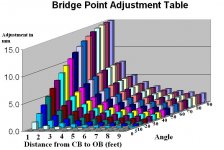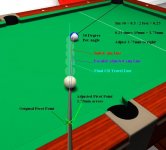Colin Colenso, I'm reposting these pictures from the "mathematical aiming system" thread you created, because they are incredibly relevant to resolving the pivot system arguments. If the graph below actually represents the variety of pivots/bridge hand adjustments required to pocket the variety of labelled shots, then way back in November of 2005 you had already proven that one or two pivots do not fit all shots. Thanks for sparing me from having to create my own experiments. I'd rep you up and down, but I did so too recently.
If a system can place the bridge hand in a simpler way than you explain here:
http://forums.azbilliards.com/showthread.php?t=21113&page=3
then it would certainly be a fantastic system. But looking at your graph and seeing how many subtle adjustments would have to be made, I doubt very much that a simple system could do all of the math on its own.


If a system can place the bridge hand in a simpler way than you explain here:
http://forums.azbilliards.com/showthread.php?t=21113&page=3
then it would certainly be a fantastic system. But looking at your graph and seeing how many subtle adjustments would have to be made, I doubt very much that a simple system could do all of the math on its own.

